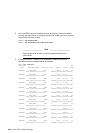
• Display the target ID mappings for a Fibre Channel adapter
• Display the current Fibre Channel topology for a Fibre Channel adapter
You have already seen how you can perform these functions from the
command line. The same output is available using the interactive mode by
selecting the appropriate option (shown in the following example).
When you start the emxmgr utility with no command-line options, the
default device used is the first Fibre Channel adapter it finds. If you want to
perform functions for another adapter, you must change the targeted adapter
to the correct adapter. For instance, if emx0 is present, when you start the
emxmgr interactively, any commands executed to display information will
provide the information for emx0.
______________________ Note _______________________
The emxmgr has an extensive help facility in the interactive mode.
An example using the emxmgr in the interactive mode follows:
# emxmgr
Now issuing commands to : "emx0"
Select Option (against "emx0"):
1. View adapter’s current Topology
2. View adapter’s Target Id Mappings
3. Change Target ID Mappings
d. Display Attached Adapters
a. Change targeted adapter
x. Exit
----> 2
emx0 SCSI target id assignments:
SCSI tgt id 0 : portname 5000-1FE1-0000-0CB2
nodename 5000-1FE1-0000-0CB0
SCSI tgt id 5 : portname 1000-0000-C920-A7AE
nodename 1000-0000-C920-A7AE
SCSI tgt id 6 : portname 1000-0000-C920-CD9C
nodename 1000-0000-C920-CD9C
SCSI tgt id 7 : portname 1000-0000-C921-0D00 (emx0)
nodename 1000-0000-C921-0D00
Select Option (against "emx0"):
1. View adapter’s current Topology
6–62 Using Fibre Channel Storage


















